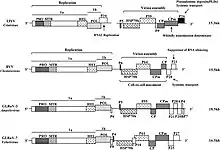| Closteroviridae | |
|---|---|
 | |
| Virus classification | |
| (unranked): | Virus |
| Realm: | Riboviria |
| Kingdom: | Orthornavirae |
| Phylum: | Kitrinoviricota |
| Class: | Alsuviricetes |
| Order: | Martellivirales |
| Family: | Closteroviridae |
| Genera | |
Closteroviridae is a family of viruses.[1] Plants serve as natural hosts. There are four genera and 59 species in this family, seven of which are unassigned to a genus.[2][3] Diseases associated with this family include: yellowing and necrosis, particularly affecting the phloem.[3][4]
Taxonomy

Genome type and transmission vector are two of the most important traits used for classification. Ampeloviruses and Closteroviruses have monopartite genomes and are transmitted by pseudococcid mealybugs (and soft scale insects) and aphids respectively. While Criniviruses are bipartite and transmitted by whiteflies.[3]
Genera:[2]
Unassigned species:[2]
- Actinidia virus 1
- Alligatorweed stunting virus
- Blueberry virus A
- Megakespama mosaic virus
- Mint vein banding-associated virus
- Olive leaf yellowing-associated virus
- Persimmon virus B
Structure
Viruses in the family Closteroviridae are non-enveloped, with flexuous and filamentous geometries. The diameter is around 10–13 nm, with a length of 950–2200 nm. Genomes are linear and non-segmented, bipartite, around 20kb in length.[3] [4]
| Genus | Structure | Symmetry | Capsid | Genomic arrangement | Genomic segmentation |
|---|---|---|---|---|---|
| Crinivirus | Filamentous | Non-enveloped | Linear | Bipartite | |
| Velarivirus | Filamentous | Non-enveloped | Linear | Monopartite | |
| Closterovirus | Filamentous | Non-enveloped | Linear | Monopartite | |
| Ampelovirus | Filamentous | Non-enveloped | Linear | Monopartite |
Life cycle
Viral replication is cytoplasmic. Entry into the host cell is achieved by penetration into the host cell. Replication follows the positive stranded RNA virus replication model. Positive stranded rna virus transcription is the method of transcription. The virus exits the host cell by tubule-guided viral movement. Plants serve as the natural host. Transmission routes are mechanical.[3][4]
| Genus | Host details | Tissue tropism | Entry details | Release details | Replication site | Assembly site | Transmission |
|---|---|---|---|---|---|---|---|
| Crinivirus | Plants | None | Viral movement; mechanical inoculation | Viral movement | Cytoplasm | Cytoplasm | Mechanical inoculation: insects |
| Velarivirus | Plants | None | Viral movement; mechanical inoculation | Viral movement | Cytoplasm | Cytoplasm | Mechanical inoculation: insects |
| Closterovirus | Plants | None | Viral movement; mechanical inoculation | Viral movement | Cytoplasm | Cytoplasm | Mechanical inoculation: insects |
| Ampelovirus | Plants | None | Viral movement; mechanical inoculation | Viral movement | Cytoplasm | Cytoplasm | Mechanical inoculation: insects |
References
- ↑ Fuchs, M; Bar-Joseph, M; Candresse, T; Maree, HJ; Martelli, GP; Melzer, MJ; Menzel, W; Minafra, A; Sabanadzovic, S; ICTV Report Consortium (April 2020). "ICTV Virus Taxonomy Profile: Closteroviridae". The Journal of General Virology. 101 (4): 364–365. doi:10.1099/jgv.0.001397. PMC 7414439. PMID 32134375.
- 1 2 3 "Virus Taxonomy: 2020 Release". International Committee on Taxonomy of Viruses (ICTV). March 2021. Retrieved 14 May 2021.
- 1 2 3 4 5 "ICTV Report Closteroviridae".
- 1 2 3 "Viral Zone". ExPASy. Retrieved 15 June 2015.